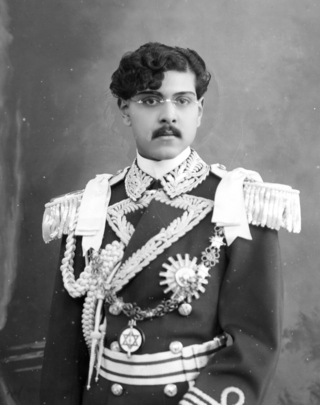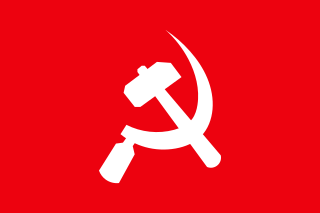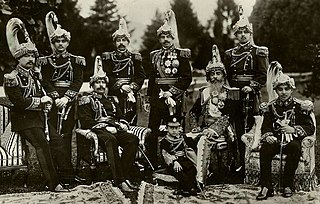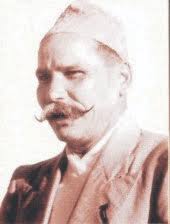
Tribhuvan Bir Bikram Shah was King of Nepal from 11 December 1911 until his death. Born in Kathmandu, the capital city of Nepal, he ascended to the throne at the age of five, upon the death of his father, Prithvi Bir Bikram Shah, and was crowned on 20 February 1913 at the Nasal Chowk, Hanuman Dhoka Palace in Kathmandu, with his mother acting as regent. At the time of his crowning, the position of monarch was largely ceremonial, with the real governing power residing with the Rana family.

The Nepali Congress is a social democratic political party in Nepal and the largest party in the country. The party has 870,106 members as of the party's 14th general convention in December 2021 making them the largest party by membership in Nepal.

The Communist Party of Nepal, abbreviated CPN, was a communist party in Nepal from 1949 to 1962. It was founded on 15 September 1949 to struggle against the autocratic Rana regime, feudalism, and imperialism. The founding general secretary was Pushpa Lal Shrestha. The founding members of the Communist Party of Nepal were Moti Devi Shrestha, Niranjan Govinda Vaidya, Nar Bahadur Karmacharya and Narayan Bilas Joshi.
Samyukta Prajatantra PartyNepal was a political party in Nepal. The party was led by Kunwar Inderjit Singh.

Rana dynasty was a Chhetri dynasty that imposed totalitarianism in the Kingdom of Nepal from 1846 until 1951, reducing the Shah monarch to a figurehead and making Prime Minister and other government positions held by the Ranas hereditary. They claimed Kshatriya status themselves. Rana dynasty is historically known for the iron-fisted rule. This changed after the Revolution of 1951 with the promulgation of a new constitution, when power shifted back to the monarchy of King Tribhuvan.

Subarna Shamsher Rana was a leading figure in the movement to overthrow the ruling Rana oligarchy and to establish democracy in Nepal. He was one of the three leaders of the Nepali Congress in the late 1940s, opposing his relatives, the Rana family, who held power in Nepal at the time.
Local elections to a municipal council for Kathmandu, the capital of Nepal, were first held on September 9, 1953. Candidates nominated by the illegal Communist Party of Nepal got 50% of the total votes cast. Out of a total of 19 seats, six were won by communists, four by Nepali Congress, four by Praja Parishad, one by Gorkha Parishad and four by independents.

Kunwar Indrajit Singh, popularly known as Dr. K.I. Singh or just K.I. Singh was a Nepali politician and revolutionary who served as the 20th Prime Minister of Nepal in 1957. He was key Nepali Congress in organizing the 1951 Nepali Revolution, and was a leader in its militant wing, the Muktisena, who later refused to recognize the Delhi Accord and was forced to flee the country following a revolt he took part in. In 1955 he returned and formed the United Democratic Party, and following the installation of the Panchayat system he agitated for its end, for which he was jailed. Following his release, he went into self-imposed exile, and much later returned to Nepal and was elected a member to the Rastriya Panchayat. He was known as the "Robin Hood of the Himalayas", and was very popular throughout the country.

Tanka Prasad Acharya was a Nepali politician who served as the 19th Prime Minister of Nepal from 1956 to 1957. He was one of the founders and the leader of the Nepal Praja Parishad, the first political party in Nepal with the goal of removing the Rana Dynasty's dictatorship.

The history of the city of Kathmandu, which is inseparable from that of the Kathmandu valley, dates back to ancient times.

General elections were held in Nepal from 18 February to 3 April 1959 to elect the 109 members of the first House of Representatives, the lower house of the Parliament of Nepal. They were held under the provisions of the 1959 constitution, which had been adopted on 12 February. More than 4.25 million people out of an overall population of about 8.55 million (1954) were eligible to vote. Voter turnout was 42.18%.

The Nepal Praja Parishad was the first attempt to form an organization to lead the revolution against the Rana dynasty in Nepal. Led by Tanka Prasad Acharya, the group was founded in 1936, and is seen as the first political party in Nepal. The organisation collapsed after their plot to assassinate multiple members of the Rana regime was discovered, and some of its key members were executed.

The revolution of 1951 in Nepal, also referred to as Sat Salko Kranti, was a political movement against the direct rule by the Rana dynasty of Nepal which had lasted for 104 years. It marks the beginning of the political awakening and democratic movements in Nepal, and resulted in immediate abolition of the institutionalized hereditary Prime Minister system in Nepal.

Mohan Shumsher Jang Bahadur Rana formed the first government of Nepal after the 1951 democracy movement. The government was formed by the proclamation of King Tribhuvan on 17 February 1951 and incorporated members of the Rana regime and the Nepali Congress. The king retained the right to dissolve the cabinet at any time and the cabinet would be responsible to him and the prime minister was to inform the king of all decisions.

Matrika Prasad Koirala formed the first government of Nepal by a commoner after he was appointed as the prime minister by King Tribhuvan. The government was formed after the previous government under Mohan SJB Rana fell after Nepali Congress ministers resigned. King Tribhuvan made a royal proclamation on 16 November 1951 and invited Matrika Prasad Koirala from the Nepali Congress to form the government.

Matrika Prasad Koirala formed his second government in 1953 after his appointment by King Tribhuvan. The cabinet was expanded in February 1954 to include Nepal National Congress, Nepal Praja Parishad and Nepali Jan Congress.

Tanka Prasad Acharya formed a government on 27 January 1956 after being appointed as prime minister by King Mahendra. The cabinet was expanded in February 1957 to add more deputy ministers.
The Prachanda Gorkha was a secret society launched to overthrow the Rana dynasty from power in Nepal.

Nepali National Congress was a political party in Nepal. It was formed by B. P. Koirala, Matrika Prasad Koirala, Ganesh Man Singh, Krishna Prasad Bhattarai, Mahendra Narayan Nidhi and others.













